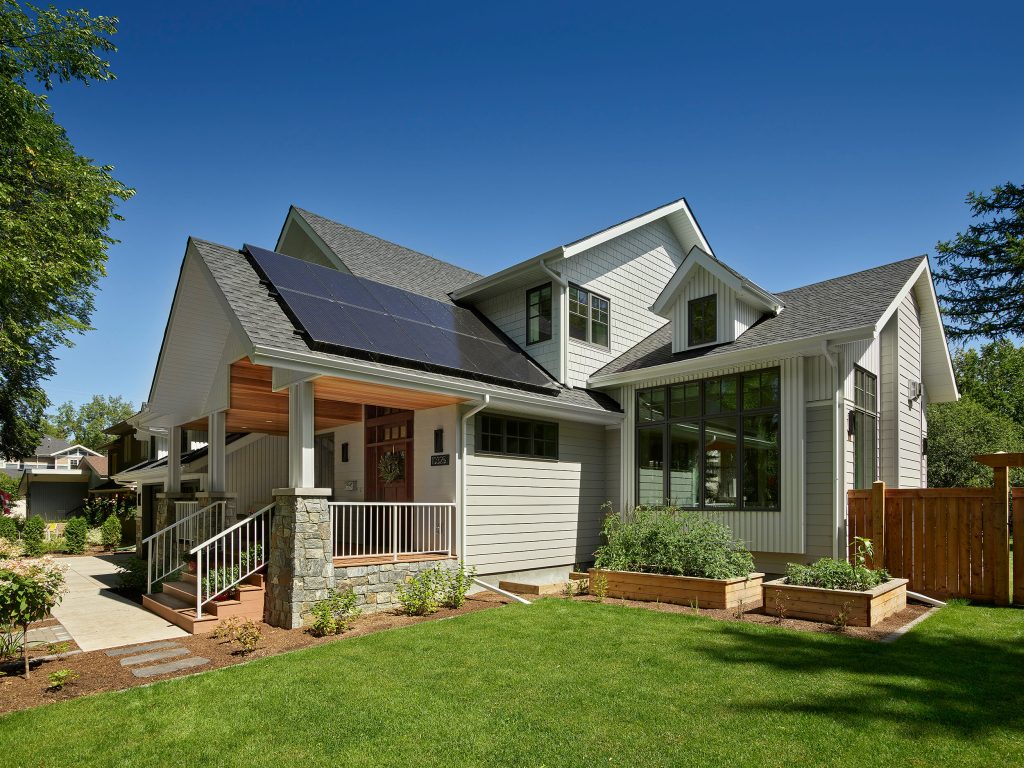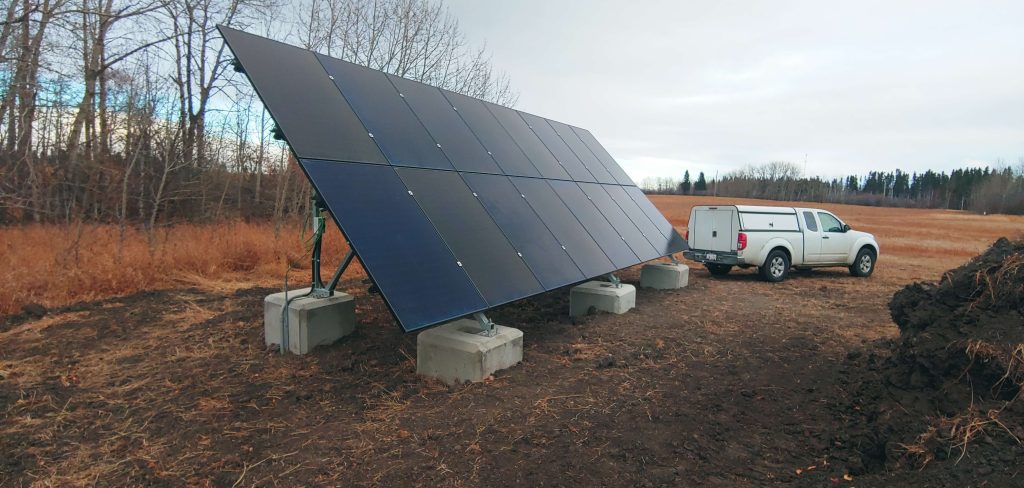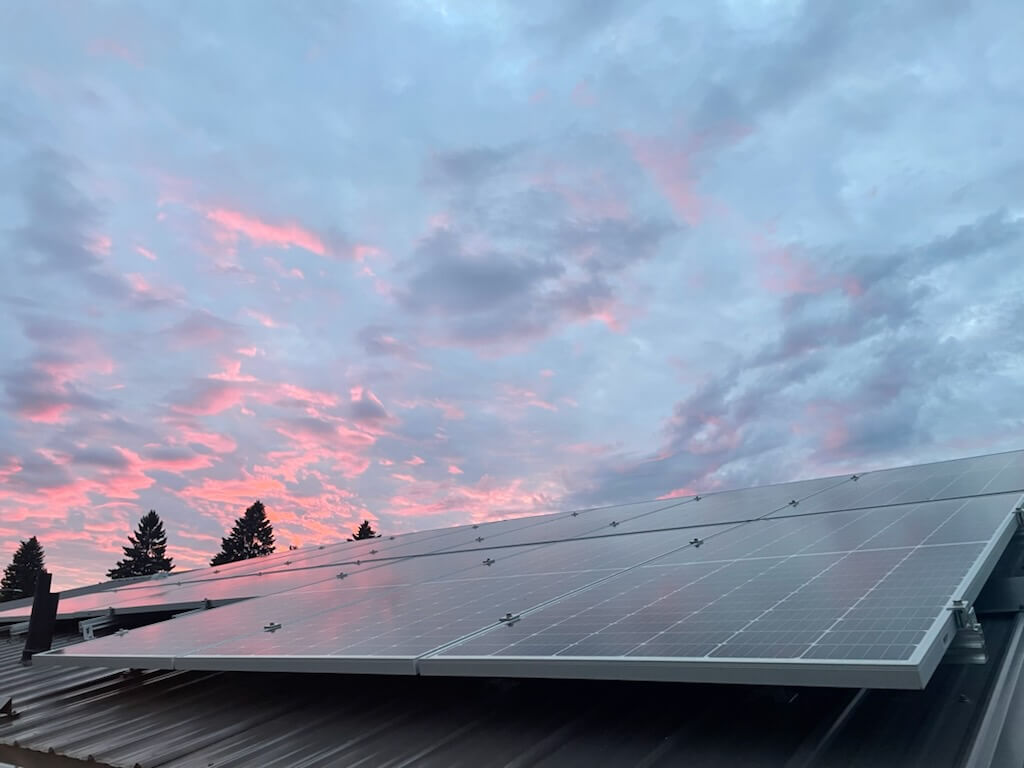At Habitat Studio, our goal is to minimize the impact of our homes on the environment with energy conscious building practices that will benefit Edmonton and the Earth for generations. Energy efficient building methods or upgrades should always be completed first, and one of the last steps to being as efficient as possible is to generate your own energy, most often done with solar power.

Why Choose Solar?
As the sunniest province in Canada with an average of 312 sunny days per year, Alberta is the perfect place to harness solar power for our homes. Paying for electricity is increasingly expensive and costs can be unpredictable. Harnessing solar energy for electricity production gives you an opportunity to regain some control over your household energy costs, while benefiting the environment.
How does my home use solar energy?
Part of a solar Photovoltaic (PV) system is a piece of equipment called the inverter that connects directly to your electrical panel. The inverter will take the DC electricity produced by the solar panels and will convert it to usable AC electricity for your home.
How do I know how much solar I need?
It all depends on how much electricity you use in a year. Habitat Studio will ask to review a minimum of 12 months of your electricity bills to get an accurate idea of how big of a solar PV system you will need to fully offset your annual electricity consumption.
Current legislation in Alberta stipulates that a homeowner with a solar PV system (also known as a microgenerator) can offset up to 100% of their annual electricity needs. For example, if a home uses an average of 600 kWh/month, that equals 7,200 kWh/year of electrical energy used. This household is allowed to install a solar PV system that will produce 7,200 kWh/year of solar energy.
With solar power, the bulk of the energy is produced in the summer months, with relatively little energy produced in the winter. The example PV system that produces 7,200 kWh/year, may produce 1,100 kWh in July, but only 120 kWh in January. It is the annual amount of energy that matters to meet the regulations in Alberta.

When will I recoup my investment on my solar array?
The annual savings of a PV system is dependent on a number of variables, including the size and orientation of the PV system, your electrical consumption, and the rates that you pay for your electricity. The typical, well designed PV system will payback in 10-15 years when all of these factors are considered (but can take shorter or longer, depending on the various factors mentioned above)
Is there anything I can do to recoup my investment quicker?
There are, however, things that you, the homeowner, can do to help recoup your investment faster. Solar energy is much more valuable (about twice as much) if you use that solar energy in your home as it is being produced instead of selling your excess solar energy back to the grid.
Let’s use an Edmonton relative example. Solar energy used in the home has a value of about $0.16/kWh (because you are avoiding buy electricity from the grid, and the delivery fees along with it), and solar energy sold back to the grid has a value of about $0.07/kWh (This will of course depend on where you live in Alberta, and the electricity rate plan you are on). You can increase the solar energy you use in your home by utilizing the time delay functions on your appliances (dishwasher, washer, dryer, etc) so that they run in the daytime instead of in the early mornings or late evenings.
Another way to increase the value of your solar energy is by getting your electricity from a retailer that offers a Solar Club electricity rate. A Solar Club electricity rate is high in the summer ($0.27/kWh) and low in the winter ($0.08/kWh). This allows you to sell your excess solar energy in the summer at a high credit rate when you sell more energy than you buy, and then in the winter the low rate lets you buy cheaper electricity when you are buying more energy than you sell. Depending on a few site factors, a Solar Club rate plan has the potential to shave years off the payback of your PV system!

How long would a system last?
There are two major parts to a PV system, the solar panels that you see on the roof, and then there is the inverter(s) that convert the solar panels DC electricity to AC electricity that you use in your home. All solar panels are warranted to perform for 25 years but are expected to operate for 30+ years because they are a simple, solid-state device with no moving parts. The inverters generally have a life expectancy of about 15 years and will need to be replaced once during the lifetime of the panels. The inverter replacement typically only costs a fraction of what was paid for the original PV system.
What should I do if I have more questions?
Give us a call! Our team is happy to answer any questions you may have and we also offer free no obligation on site quotes. You can also visit our Solar page for more information.
